Sundial Bridge: An Architectural Gem with an Uncommon Design
The Redding, CA landmark offers easy access, away from the bustle
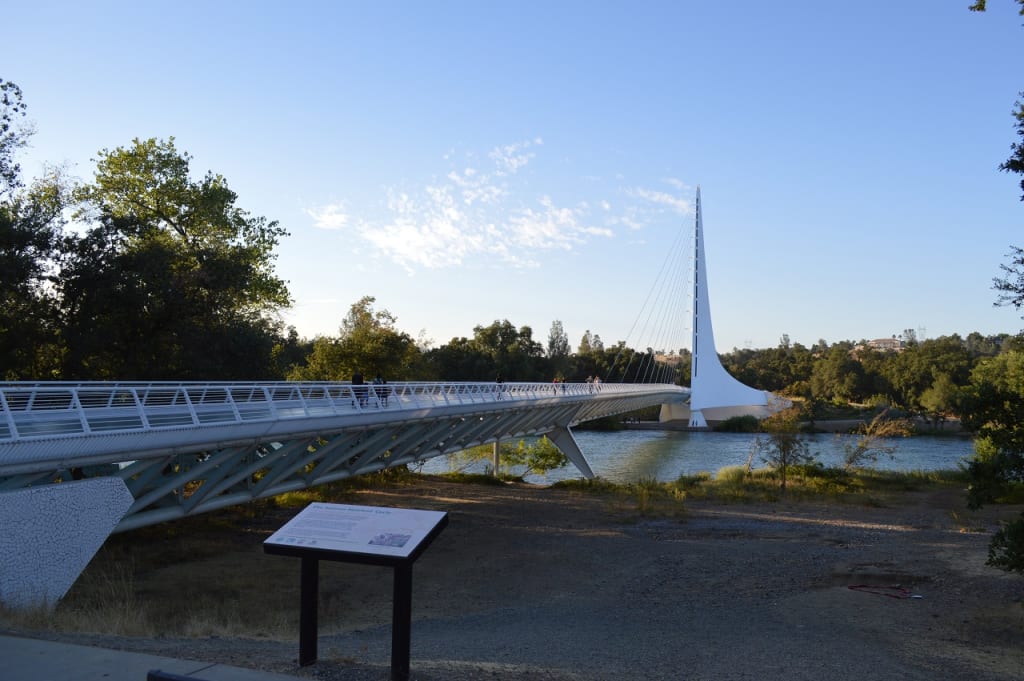
I stood mesmerized by the sleek, slanted, gleaming white column brightly lit by the evening sun against the clear blue sky. The cables tying the column to where I was standing, a pedestrian bridge across the Sacramento River in Redding, California with translucent glass panels for the deck, made it all the more intriguing and aesthetically pleasing.
I got the first glimpses of the Sundial Bridge when a friend of ours had visited and posted its pictures years ago. The photos were so intriguing that I wanted to visit the bridge. But it would be more than five years before I could fulfill that plan!
The wait was worth it.
Design
Designed by Santiago Calatrava, a Spanish Swiss architect of international renown, the bridge sports a massive tower. As a structural engineer, Calatrava has a long list of projects around the world known for their architectural statements.
The Sundial Bridge in Redding uses many of the design elements of Calatrava’s other projects but adds a twist too.
The bridge features a tower, slanted at 42 degrees, that appears to reach for the heavens. It acts as a cantilever and counterbalances the weight of the bridge with the help of 14 cables. The strength and integrity of these cables are vital. They support both the tower and the bridge by helping them counterbalance each other. Their visual aesthetics are what we see and enjoy as we take a stroll.
The Sundial Bridge is an assembly of parts manufactured in faraway locations. The steel cables were made in England; the translucent glass panels that form the deck came from Quebec; the steel support structure of the bridge itself was made in Vancouver, Washington; and Spain provided the broken white tiles used for decoration of the sundial.
Interestingly, this bridge uses gravity in a creative way. The conventional design uses support on either bank (and sometimes more) of a river. This keeps the deck of the bridge from collapsing due to gravity. Calatrava’s design uses the gravitational pull on the bridge as well as the pylon tower to cancel each other through the tension in the cables.

I visualize these by picturing two yoga poses — the plank (left) and the modified boat pose (right). Plank exemplifies the conventional bridge where the torso and the legs are like the deck of the bridge with firm supports on both sides, namely the feet and the hands (or elbows depending on how the yogi does it). The modified boat pose I am thinking of is where the body is in the boat pose but the hands are grasping the legs. In this picture, the legs are the bridge deck and the upper body is the pylon, with the hands acting like the cables that help the two parts counterbalance each other. We take a little artistic license here, as the legs are not horizontal. The model applies, however, in depicting the forces involved.
While it looks sleek and inviting, the cantilever design is not as strong as the regular construction. Think of someone pushing the yogi in the poses above. It would take considerable effort to push a yogi in the plank pose to fall over. But it is quite easy to do the same to the yogi in the modified boat pose. The Sundial Bridge serves just pedestrians and bicyclists and so the challenges to its stability are more manageable.
Aesthetics and driving traffic
The engineer in me marveled at the delicate details of the construction. But the artist in me just saw the aesthetics and the ambiance on that cloudless, balmy, summer day.

The emphasis on aesthetics at the expense of robust engineering appears deliberate. The project started in the early 1990s with the goal of increasing tourism in the Redding area. It was a conscious decision to add a bridge where there was none before and drive more traffic to the area. The project ended up costing eight times the original estimate. But it was successful after its opening in 2004. Visitations rose 42% in the first year. Millions of dollars worth of commerce and tourism ensued each year thereafter.
Sundial Bridge cares about ecology
One of the design decisions was to leave the river free of obstructions for salmon to migrate up the river during the salmon run. The Sacramento River offers an important spawning habitat for the Pacific Salmon that swim upstream to multiply for the next season.
The 700-foot span of the bridge has no touchpoint in the river itself. The cantilever design made this possible, as seen below.
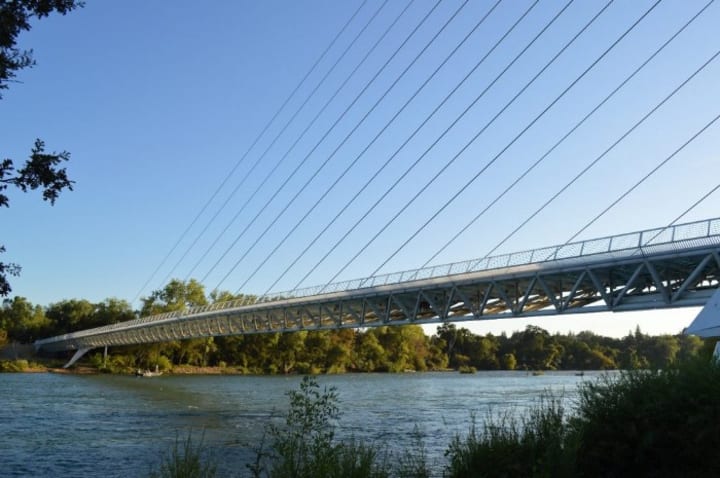
Another aspect of the bridge that’s special is the translucent structural glass panels that form the deck of the bridge. These allow light to pass through them, and this is supposed to maintain the natural environment as intact as feasible (by not blocking sunlight) for the salmon in the water.
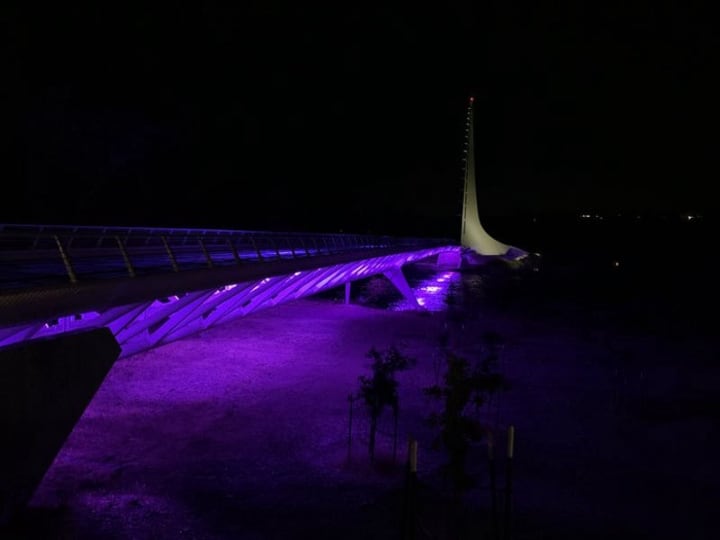
But the bridge is lit from below in the night. That ruins the advantage of translucence if you ask me; it compromises the night experience for the salmon! The only beneficiary seems to be the pedestrians and cyclists who would have light in the night for their own safety and enjoyment.
The sundial
Keeping with the theme of entertaining tourists, a twist in the construction adds to the experience: The sundial. The 42-degree angle of the tower, as it is pointing precisely North, opens up the possibility of a sundial. There is a sundial patch built into the grounds. The tower acts as the giant gnomon and the markings on the ground act as the dial. But it may be that it is more of a talking point than of any utility. It indicates the correct time on only one day of the year: the summer solstice, on June 20 or 21. Regardless, it gives the bridge its catchy name.
Verified!
While my first trip to the Sundial Bridge was part of a massive road trip in 2017, it didn’t happen on the solstice day for me to verify the accuracy of the sundial. This year, in 2021, the summer solstice was on Sunday, June 20th. So, my wife and I undertook a convenient weekend trip to Redding in June to do that verification.
The adventure started early. It was supposed to be a simple 4-hour drive up to Redding where we would take in the sundial’s performance, check out a couple of other locations in the area, and get back home on Sunday.
The drive up was anything but smooth! Though sobering after the fact, we are grateful for our luck that kept us reasonably on schedule and, most importantly, safe. Once in Redding, everything went according to plan.
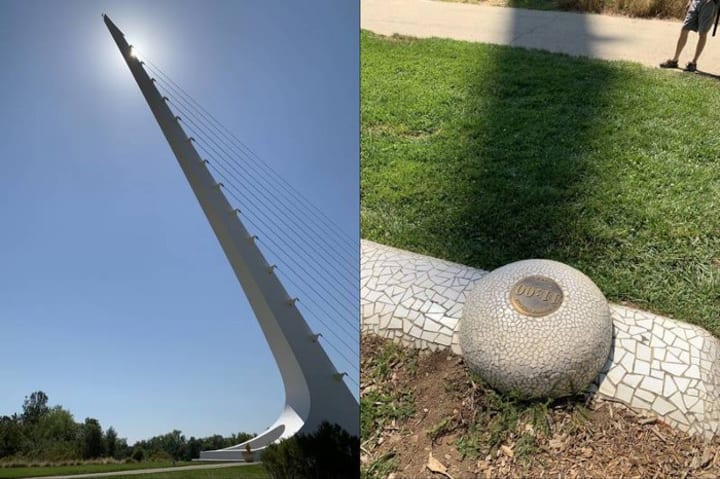
You can see that the sundial was spot on, with one edge of the shadow showing the precise time when the photo was taken: 11 am.
Sundial Bridge: A worthwhile stop
All in all, the Sundial Bridge lives up to its purpose. It attracts tourists with its interesting architecture, beautiful views of the Sacramento River, and fun with the sundial. It attracted me to make the trip, contribute to the local economy through our lodging and food expenditure, among others. I found that, despite COVID-19 concerns, there were a number of visitors in the scorching sun to check out the accuracy of the sundial!
Want to visit?
Sundial Bridge is situated in the city of Redding, California, with quick and easy access from Interstate 5. Yet, it is secluded and shielded from city noise for a peaceful sojourn.
The bridge and its surroundings offer a perfect day trip destination for the entire family. If you are visiting with children, you will want to check out the Turtle Bay Exploration Park in the vicinity. Parking and bridge access is free, and the bridge is open through the night.
For more information on the bridge including its history, please visit Turtle Bay Exploration Park website.
----------------------------------------------------------------------------------------
This article has been published in other locations online (originally here), but now adopts vocal.media as its primary home.
Please visit pvenkatraman.com to read other writings of mine.
Please subscribe to my newsletter (currently weekly) if you wish to receive them directly in your inbox.
About the Creator
P. Venkat Raman
I write on diverse topics such as Personal Development, Travel, Finance, Gardening, Food, etc. I am a Vocal.Media member since Oct 2021.


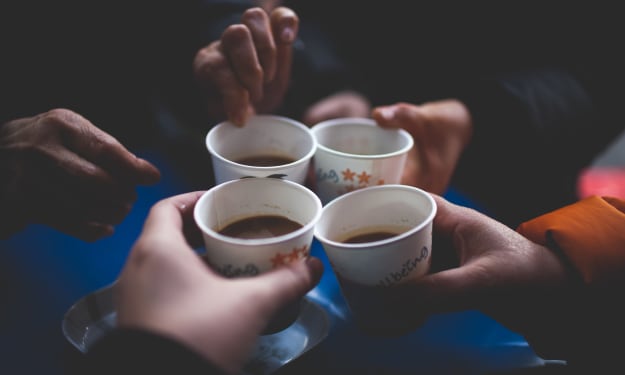



Comments
There are no comments for this story
Be the first to respond and start the conversation.